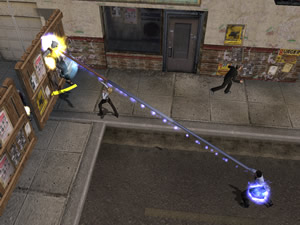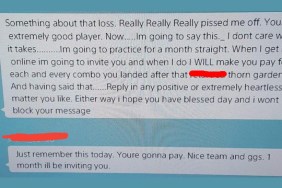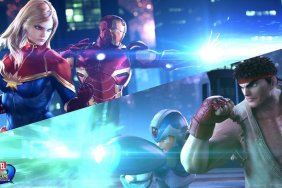Flame off.
If you set your expectations low enough, you can enjoy just about anything. This certainly goes for Activision’s new merchanding device disguised as an actual game, Fantastic Four. If you expect a bad action game with small, linear environments, zero A.I. and even less replay value, you deseve a pat on the back for hitting the nail on its orange, rocky head.
Then if you go on to play the game, you might be pleasantly surprised to discover a decent control scheme and a liberal helping of mini-bosses that consistently break up the tedium. But your capacity to look on the bright side will quickly be tested after a few hours of mindless button mashing. While we’re sure that some determined fans could still enjoy this game, we’d rather set our expectations on fun.
And we wish Activision would do the same. For starters, they need to hire an editor to tell them that their weird, chopped-up version of the movie’s plot doesn’t make a bit of sense. Like the film, the game begins in space where Reed Richards, Ben Grimm, Johnny Storm, Sue Storm and Victor Von Doom are looking into the properties of some cosmic anomaly when it suddenly infuses one and all with crazy space rays. But instead of popping like eggs in a microwave, they all gain amazing super-powers. I know, I was disappointed, too.
Anyway, where the movie goes on to lightly chronicle the conflict between Von Doom and Reed Richards and the human drama of a man who has become a Thing, the game jumps into a sewer level, then a museum level, then an Aztec level. Random villains pop up and then exit as quickly as they came. Some levels have you searching for meteorites. Don’t get me wrong – I’m all for running around in the sewers fighting raptors – I just like to know why I’m doing it and where the damned things came from. Did somebody flush one down the toilet or something?
To dispatch such dubious dinosaurs, you play as all four members of the squad, switching between them using the D-Pad as the A.I. handles the other three. Regardless of the hero, you get light and heavy melee attacks, a throw, a block, a jump and a super-power button. The controls are simple and easy to learn, and they get a little bit more involved as you progress into the game because you start unlocking combos and upgrades.
Don’t expect insane depth, though. Not only does each character uses the same exact control scheme, they pretty much are the same. The Human Torch is the only exception – he hits like a little girl and takes a punch like one, too, but can do good fireball damage from afar. The Thing, The Invisible Woman and Mr. Fantastic, though, are all based on the same template. Sure, Sue can turn invisible and the Thing hits a little harder than the rest, but Sue should be able to turn invisible for hours rather than seconds, the Thing should hit like an avalanche, Reed should be much more mobile, and The Human Torch should be able to fly. Duh. These characters’ identities are supposed to be based on their powers, not the generic punching and kicking combos they’re forced to rely on in the game.
At least the combos aren’t completely generic. For example, one might momentarily stun opponents, while another will hit hard and knock them back. Obviously, it’s a good idea to use the stun combo against big, scary foes, then follow up with the strong one. Once they’re down on the ground you can hit them with a long-range super attack for good measure and great damage.
 As you execute moves and kill enemies, you gain points which are shared between all the characters and can be used to buff up their individual special attacks and combos, as well as unlock stuff like interviews and concept art. Unfortunately, upgrading your combos and special attacks doesn’t do anything but tack on damage, making enemies easier to kill.
As you execute moves and kill enemies, you gain points which are shared between all the characters and can be used to buff up their individual special attacks and combos, as well as unlock stuff like interviews and concept art. Unfortunately, upgrading your combos and special attacks doesn’t do anything but tack on damage, making enemies easier to kill.
Then again, thanks to terrible, pattern-based A.I., the enemies are pretty mortal to begin with. And since they generally come in waves of five or six, you never have time to strategize. Instead, you just pound away at the buttons.
At times, you’ll wish you could pound away on your teammates, because they make the enemies look crafty. For example, there are a few platforming sequences (ugh) that force you to jump over beds of spikes. As you begin hopping about, you’ll hear your cohorts start grunting in pain and see their life bars plummet. When you get to the end and pull the “lever” to move on (double-ugh), you’ll see that they tried to follow you but wound up walking straight into the spikes, over and over. At first we assumed that this was an extreme case of Artificial Idiocy, but then we realized we would probably be doing the same thing if we were trapped in such a game.
At least the tedium of fighting dumb enemies and dealing with dumber allies is frequently broken up by mini-bosses and their masters. These guys are also pretty stupid and pattern-driven, but at least they can be relied upon to follow new and different attack sequences.
Of course, neither the regular enemies nor their masters are particularly tough to kill. Instead, your most formidable foes will be the cramped environments and reliably retarded camera. There’s nothing like being chased into a corner by a mob of ghouls only to have the camera suddenly fixate on your shoulder-blades, forcing you to take five or six nasty strikes you should have been able to avoid. You can’t duck the punches, but you can sure duck this lousy game.
Some mini-games try to keep the action from growing stale, but all are mindless (“Tap [button] quickly!”) and they regularly come in big clumps, requiring you to repeat the exact same game five or six times in a row. It makes sense to pull one bad guy off a fire-escape, but to walk down a long alleyway pulling them down left and right is far too much of a weak idea.
 While you’ll eventually pull the last enemy off the last fire escape and move onto some new, equally asinine min-game, the long alleyway never ends in Fantastic Four because the game is nothing more than one large corridor. The environments are cramped and claustrophobic and the game is completely linear ” a far cry from the open, awesome cityscape we enjoyed so much in Spider-Man 2.
While you’ll eventually pull the last enemy off the last fire escape and move onto some new, equally asinine min-game, the long alleyway never ends in Fantastic Four because the game is nothing more than one large corridor. The environments are cramped and claustrophobic and the game is completely linear ” a far cry from the open, awesome cityscape we enjoyed so much in Spider-Man 2.
Fantastic Four features co-operative play for two players. I would repeat that again, but it’s so stupid, it almost killed me the first time. Fantastic Four. Co-op for two. FOUR. TWO. Huh?
Oh well – considering how boring the game is with just two players, maybe it’s a good thing they didn’t go for four, as it limits the maximum amount of suffering. The camera goes absolutely bonkers when two people are playing, and it becomes very hard to figure out where the enemies are or where to go. There’s also an Arena mode where you can face legions of any enemies you’ve already seen in the game, like you haven’t already.
At least the graphics contain a couple nice touches. If you knock a Molotov-throwing enemy to the ground, for example, he’ll break his cocktail and set himself on fire before writhing in flaming agony. But there’s very little environmental diversity, the character models are blocky and lack detail, and bad guys regularly clip through walls or get stuck in solid structures. Although Fantastic Four is available for the Xbox, PS2 and Gamecube, it looks completely identical on all three systems and even has comparable loading times.
Fantastic Four sounds just as sketchy as it looks, thanks to poorly directed voice work and some ultra repetitive effects. Mercifully, the music never gets annoying.
That’s a lot more than can be said for the rest of the game. Even though kicking enemy butt can be satisfying and there are a lot of big, menacing monsters to face, Fantastic Four is merchandising at its finest, a hollow game that’s beatable in eight hours and isn’t replayable at all. We don’t expect you to enjoy it. We don’t expect you to buy it, either.
-
Cool Mini-bosses
-
Some good butt kicking...
-
..with tons of button mashing
-
Awful environments
-
Worse A.I.
-
No four-player??







